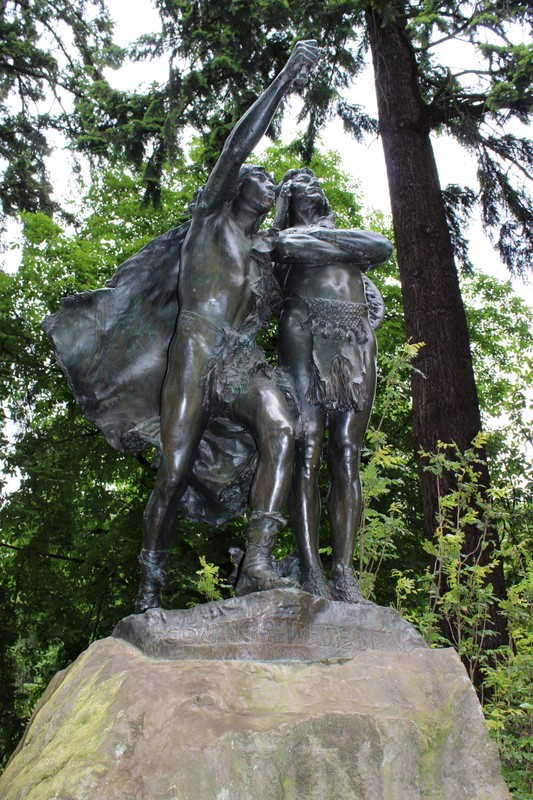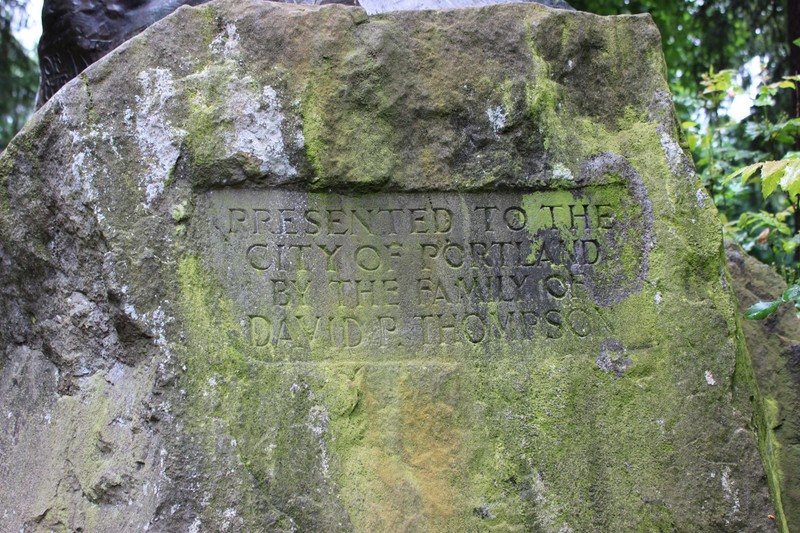Coming of the White Man statue
Introduction
Text-to-speech Audio
Images
Coming of the White Man. Photo by Cynthia Prescott.

Monument dedication. Photo by Cynthia Prescott.

Backstory and Context
Text-to-speech Audio
Coming of the White Man was originally displayed as part of the Lewis and Clark Exposition, a 1905 fair marking the centennial of the Lewis and Clark expedition's journey from Missouri to the Pacific. Herman MacNeil’s statue features two native men facing eastward toward wagon trains arriving along the Oregon Trail. Like other leading artists of his generation, MacNeil thought of indigenous North Americans as noble savages. But he was one of the first American sculptors to reject depictions of Native Americans as childlike. MacNeil nonetheless viewed indigenous peoples as innocents who would necessarily yield way to white civilization.
In Coming of the White Man, Multnomah, chief of the local Multnomah Indian tribe, stands with his arms crossed, staring haughtily as the Lewis and Clark expedition’s canoes approach down the Columbia River. Beside him, a young Indian scout points excitedly toward those arriving from the East.
At the Lewis and Clark exposition, Coming of the White Man had been juxtaposed against Frederic Remington’s Hitting the Trail, an ensemble of four exuberant cowboys on horseback, with pistols raised. These spirited cowboys stood in for the white-dominated American nation that had indeed come—and dispossessed—the indigenous peoples of the American West, beginning with the explorations of the Lewis and Clark expedition.
While some have interpreted Coming of the White Man as depicting empathy toward native people over the loss of their land and way of life, it nonetheless declared the inevitable destruction of indigenous populations. Indeed, Portland Mayor George H. Williams professed both interpretations in the same breath at its 1904 presentation ceremony:
“The historic significance of this group is the white man’s invasion of the wilderness home of the Indians. This monument will probably stand here when the race of people whom it represents has become extinct, and will then describe to those who come to see it better than any book the form, features, and chief characteristics of the original inhabitants of this country.”
Williams went on to explain that his late predecessor, David P. Thompson, had “erected…a splendid representation of our wild animals” in the form of a massive bronze elk in nearby downtown Portland, which his family “supplemented…[with] a more splendid representation of the wild men of this country.”1 Portlanders were confident that both wild Native men would eventually disappear due to the arrival of white civilization—a process made possible by the Lewis and Clark expedition.
After the fair, the statue was moved to Washington Park. It now stands near the Sacajawea statue (which was also displayed at the 1905 fair) and the 1908 Lewis and Clark Memorial Column.
Sources
Willingham, William F. “City of Portland Civic Planning, Development, & Public Works, 1851-1965: A Historic Context.” City of Portland Bureau of Planning and Sustainability. March 2009. http://www.portlandoregon.gov/parks/article/299256 . Accessed June 26, 2013.
Broder, Patricia Janis. Bronzes of the American West. New York. Harry N. Abrams, Inc., 1974.
Lubin, David M. Picturing a Nation: Art and Social Change in Nineteenth-Century America. Yale University Press, 1994.
